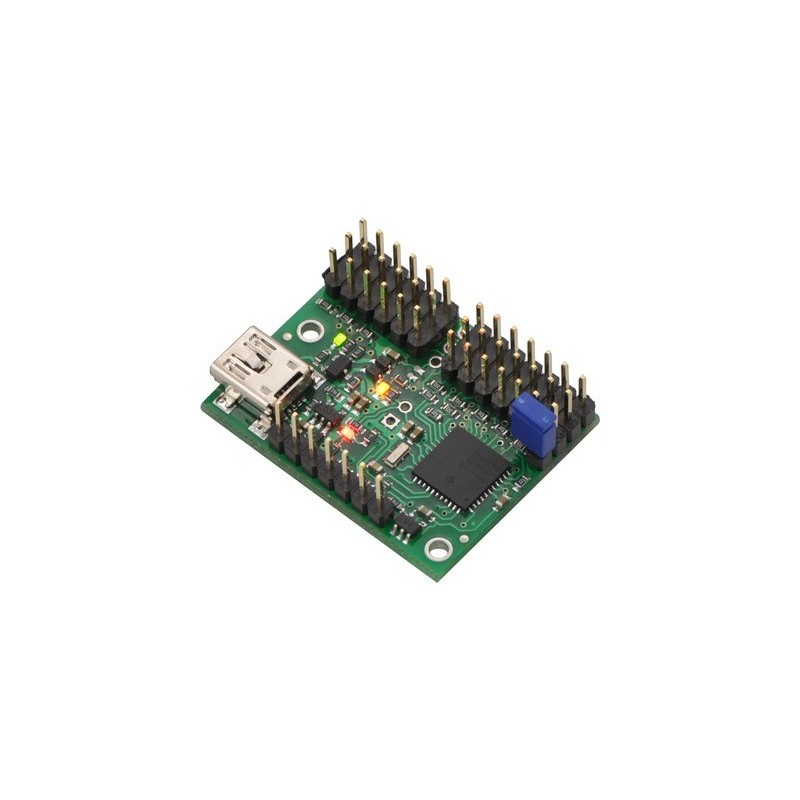

The 12-channel Mini Maestro 12 raises the performance bar for serial servo controllers with features such as a native USB interface and internal scripting control. Whether you want the best servo control available (0.25µs resolution with built-in speed and acceleration control and pulse rates up to 333 Hz) or a general I/O controller (e.g. to interface with a sensor or ESC via your USB port), this compact, versatile device will deliver. This fully-assembled version ships with header pins installed.
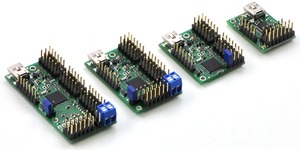 |
| Maestro family of USB servo controllers: Mini 24, Mini 18, Mini 12, and Micro 6. |
|---|
The Mini Maestros are the newest of Pololu’s second-generation USB servo controllers, offering more channels and features than the smaller six-channel Micro Maestro. The Mini Maestros are available in three sizes, and they can be purchased fully assembled or as partial kits:
The Mini Maestros are highly versatile (and compact) servo controllers and general-purpose I/O boards. They support three control methods: USB for direct connection to a computer, TTL serial for use with embedded systems, and internal scripting for self-contained, host controller-free applications. The channels can be configured as servo outputs for use with radio control (RC) servos or electronic speed controls (ESCs), as digital outputs, or as analog/digital inputs. The extremely precise, high-resolution servo pulses have a jitter of less than 200 ns, making these servo controllers well suited for high-performance applications such as robotics and animatronics, and built-in speed and acceleration control for each channel make it easy to achieve smooth, seamless movements without requiring the control source to constantly compute and stream intermediate position updates to the Mini Maestros. The Mini Maestros also feature configurable pulse rates from 1 to 333 Hz and can generate a wide range of pulses, allowing maximum responsiveness and range from modern servos. Units can be daisy-chained with additional Pololu servo and motor controllers on a single serial line.
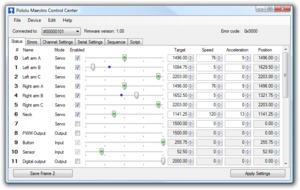 |
| The Status tab in the Maestro Control Center. |
|---|
A free configuration and control program is available for Windows and Linux, making it simple to configure and test the device over USB, create sequences of servo movements for animatronics or walking robots, and write, step through, and run scripts stored in the servo controller. The Mini Maestros’ 8 KB of internal script memory allows storage of up to approximately 3000 servo positions that can be automatically played back without any computer or external microcontroller connected.
Because the Mini Maestros’ channels can also be used as general-purpose digital outputs and analog or digital inputs, they provide an easy way to read sensors and control peripherals directly from a PC over USB, and these channels can be used with the scripting system to enable creation of self-contained animatronic displays that respond to external stimuli and trigger additional events beyond just moving servos.
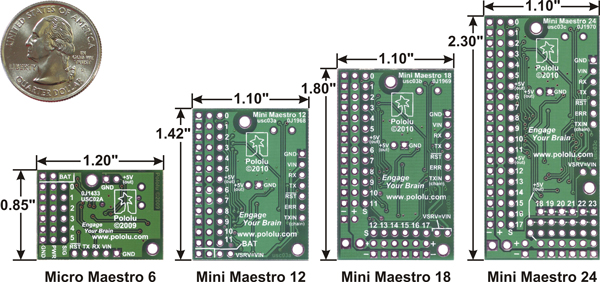 |
The fully assembled versions of the Mini Maestro ship with 0.1" male header pins installed as shown in the respective product pictures. The partial kit versions ship with these header pins included but unsoldered, which allows the use of different gender connectors or wires to be soldered directly to the pads for lighter, more compact installations. A USB A to mini-B cable (not included) is required to connect this device to a computer.
 |
| Micro Maestro 6-channel USB servo controller (fully assembled) controlling three servos. |
|---|
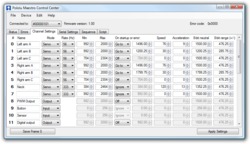 |
| The Channel Settings tab in the Maestro Control Center. |
|---|
 |
 |
 |
 | |
|---|---|---|---|---|
| Micro Maestro | Mini Maestro 12 | Mini Maestro 18 | Mini Maestro 24 | |
| Channels: | 6 | 12 | 18 | 24 |
| Analog input channels: | 6 | 12 | 12 | 12 |
| Digital input channels: | 0 | 0 | 6 | 12 |
| Width: | 0.85" (2.16 cm) | 1.10" (2.79 cm) | 1.10" (2.79 cm) | 1.10" (2.79 cm) |
| Length: | 1.20" (3.05 cm) | 1.42" (3.61 cm) | 1.80" (4.57 cm) | 2.30" (5.84 cm) |
| Weight(1): | 3.0 g | 4.2 g | 4.9 g | 6.0 g |
| Configurable pulse rate(2): | 33–100 Hz | 1–333 Hz | 1–333 Hz | 1–333 Hz |
| Pulse range(2): | 64–3280 ěs | 64–4080 ěs | 64–4080 ěs | 64–4080 ěs |
| Script size(3): | 1 KB | 8 KB | 8 KB | 8 KB |
1 This is the weight of the board without header pins or terminal blocks.
2 The available pulse rate and range depend on each other and factors such as baud rate and number of channels used. See the Maestro User’s Guide for details.
3 The user script system is more powerful on the Mini Maestro than on the Micro Maestro. See See the Maestro User’s Guide for details.
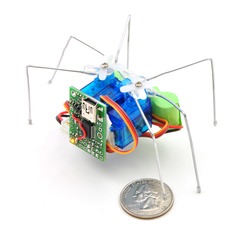 |
| Micro Maestro as the brains of a tiny hexapod robot. |
|---|
An example setup using a Micro Maestro to control a ShiftBar and Satellite LED Module is shown in the picture below and one of the videos above. Maestro source code to control a ShiftBar or ShiftBrite is available in the Example scripts section of the Maestro User’s guide.
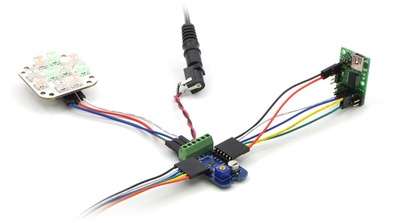 |
| Connecting the Micro Maestro to a chain of ShiftBars. A single 12V supply powers all of the devices. |
|---|
 |
Micro Maestro 6-Channel USB Servo Controller (Assembled) |
 |
USB Cable A to Mini-B 6 ft. |
 |
0.1" (2.54mm) Crimp Connector Housing: 1x3-Pin 25-Pack |
Manufacturer BTC Korporacja sp. z o. o. Lwowska 5 05-120 Legionowo Poland sprzedaz@kamami.pl 22 767 36 20
Responsible person BTC Korporacja sp. z o. o. Lwowska 5 05-120 Legionowo Poland sprzedaz@kamami.pl 22 767 36 20
Cable with USB plugs type A and mini-USB type B, cable with a length of 1.8 m
No product available!
Mini Maestro 12 in kit version is a multifunctional controller for controlling servos, reading sensors, and executing motion sequences without a computer. Excellent for use in robotics, animatronics, and interactive systems, it enables flexible motion control and peripheral management from a PC or microcontroller.
No product available!
This module supports four servos with direct power supply ranging from 5-17V, allowing for the construction of high-power designs. The module features standard servo connectors and two analog inputs that can be used to interface with sensors or servos with feedback. Pimoroni PIM695
This Kit with fully-dedicated PWM driver chip handles all the motor and speed controls over I2C. Only two data pins (SDA & SCL in addition to the power pins GND & 5V) are required to drive the multiple motors; you can also connect any other I2C devices or shields to the same pins. This makes it drop-in compatible with any Arduino, such as the Uno, Due, Leonardo and Mega R3. Adafruit 1438
Universal tester of servos and ESC regulators. It allows you to check the operation of the servo without the need for a transmitter and receiver
Adafruit 16-Channel PWM / Servo HAT for Raspberry Pi - Mini Kit (Adafruit 2327)
Pololu Micro Maestro 1351 in kit version enables precise and flexible control of servos and sensors from a PC or microcontroller. Thanks to its ability to operate autonomously and function as a USB–TTL interface, it is used in motion control systems, animatronic projects, and interactive systems responding to external stimuli.
No product available!
The expansion module is designed to work with micro:bit. It allows you to control 4 DC motors or two stepper motors and 8 servos. It communicates via the I2C interface. DFRobot DFR0548
A compact servo controller based on the PCA9685 chip, allowing simultaneous control of up to 16 RC servos. The board features a built-in Edge Connector for direct connection to the micro:bit and Link-compatible pads for easy integration with other modules. Power can be supplied via the terminal block or servo connectors, and a built-in switch and LED simplify operation. The controller provides a stabilized 3.3V output for the micro:bit and additional devices, making it a perfect central module in your project. Kitronik 5694
No product available!
Advanced servo controller with UART and USB communication, enabling precise control of multiple servos simultaneously. Compact design and stable power supply via screw connector make the device ideal for integration in robots and automation systems with limited space. Cooperation with the Seeed Studio XIAO ecosystem and the use of serial bus instead of traditional PWM provide efficient, scalable and reliable control in educational, research and DIY projects. Seeed Studio 105990190
Universal tester of servos and ESC regulators. It allows you to check the operation of the servo without the need for a transmitter and receiver
Servo control module. The operating parameters are configured by means of potentiometers placed on the board. SparkFun WIG-13118
No product available!
The motor driver card can drive 24 servo motors at most. It can be used to drive a multiple-joint robot machine, such as Hexapod Robot, Biped Robot, and Arm Robot. P0288
16-channel servo driver module with I2C interface based on the PCA9685 system. modPCA9685
No product available!
HAT module with the PCA9685 server driver designed for Raspberry Pi minicomputers. The board is equipped with a 40-pin connector. Adafruit 3416
The servo driver module is an extension intended for minicomputers Raspberry Pi Zero / Zero W / Zero WH / 2B / 3B / 3B +. Allows you to control 16 PWM channels. Waveshare 15275
No product available!
No product available!
Module with a 16-channel PWM PCA9685 driver. The board is equipped with a Grove connector and communicates via the I2C interface. Seeed Studio 108020102

